It is shortly after dusk and I am crossing a narrow alley hidden among the warehouses, behind the port of Ermoupoli, where some of the 24 textile factories of the island used to be. A young girl, holding an old-fashioned lantern in her hand, winks at me to approach and opens the metal front door. Behind it, a dreamy microcosm, reminiscent of the early 19th century, is revealed.
This is the result of the actions of Hermoupolis Heritage, an NPO that aims to highlight the special characteristics of the city’s industrial heritage. Led by Dimitris Stavrakopoulos, this organisation has already managed to turn the ruins of Zisimatos textile factory into a place of culture, where experiential night tours take place.
As I walk towards the back side of the old factory’s long, narrow courtyard, I hear the sound of a diesel engine and the tour guide, dressed in an apron like the ones once worn by the factory workers, opens the machinery-space door.
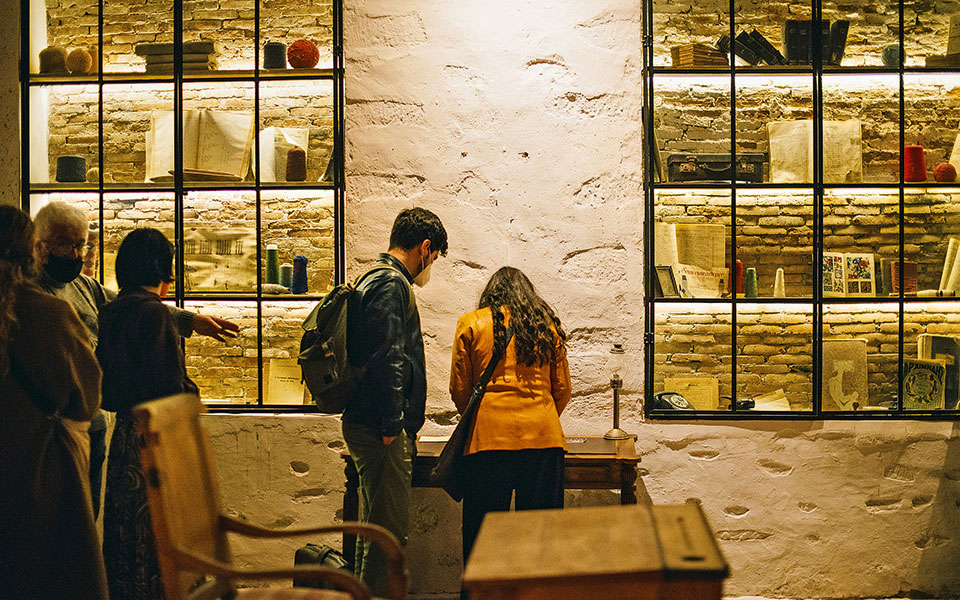
© Angelos Giotopoulos
Walking into the main areas of the textile factory, I sense the workers’ “presence” everywhere: from the wooden chairs, on which Hermoupolis Heritage has engraved their names, to the stickers that they themselves had stuck on the frames of the 1980s giant motorised Jacquard looms.
The factory operated from 1918 to 1986 and numerous “lots” of women have worked on its looms. Since many of them were very young, the machines could be compared to school desks, with one main difference – the white threads that rise from the looms all the way up to the ceiling, giving the space an overwhelming sense of vitality.
The tour continues around all the areas of the factory and passes by the atmospheric showcases where relics from other textile factories of Syros are displayed, to end with a dinner reminiscent of the workers’ collation. Sitting at a table, set with a checkered tablecloth, we are cutting tomatoes, cheese and onions using our jackknife and removing the lids from the fagiatzes, the metal utensils in which the workers used to carry their collations.
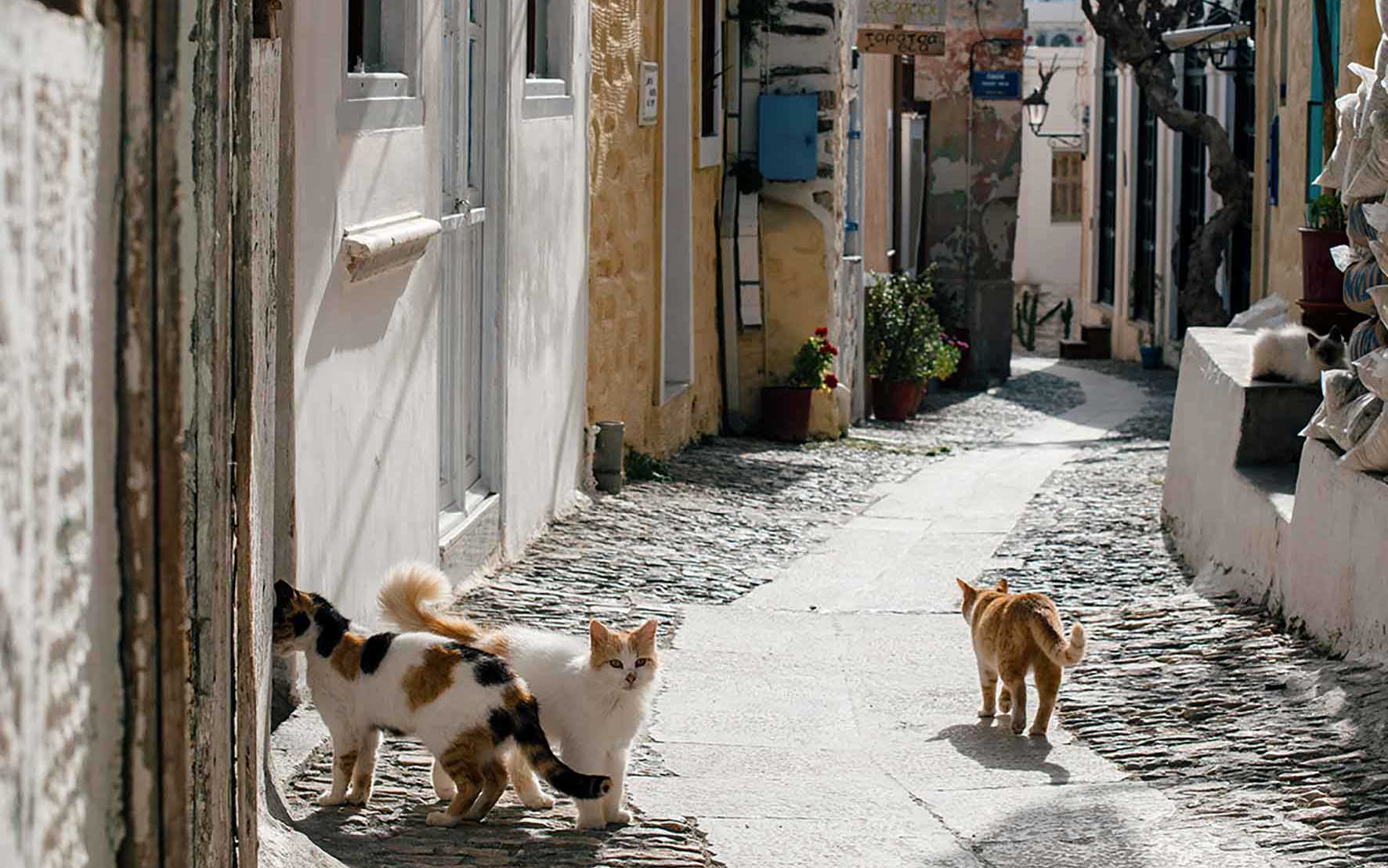
© Angelos Giotopoulos
In the Alleys of Ano Syros
At that time, out of the 3,000 local industry workers, many used to live in the impoverished settlement of Ano Syros. It is said that the hundreds of white steps of this uphill settlement were blackened each dawn by the herds that walked down to work in the factories.
Among them was Markos Vamvakaris, who worked as a child in the textile industry along with his mother. Walking around the Cycladic alleys of Ano Syros with Aristos Vamvakousis, director of the music school En Chordais kai Organis (With Strings and Pipe), I am thinking that the character of this area has changed quite a bit. Apart from the small square with the marble bust of Vamvakaris, only a few elements are reminiscent of its rebetiko past. Its white houses, some of which were built in the Middle Ages, are now used as tourist accommodations, while the tavernas and rebetadikos (places where live rebetiko music is played) have been replaced by sophisticated cocktail bars.
However, the old stone path that leads to Pateli, Nichori, Alithini and from there to Piskopio is still visible from the top of the hill. This is a path where Vamvakaris himself used to walk and which he has captured in the lyrics of his song Frangosyriani (Catholic girl from Syros). The culture of rebetiko music resonates in the strings of Aristo’s students. Some of them have created music groups that perform in various places in Ermoupoli, while the school itself participates in the Rebetiko Festival that takes place at the end of August, in Syros.
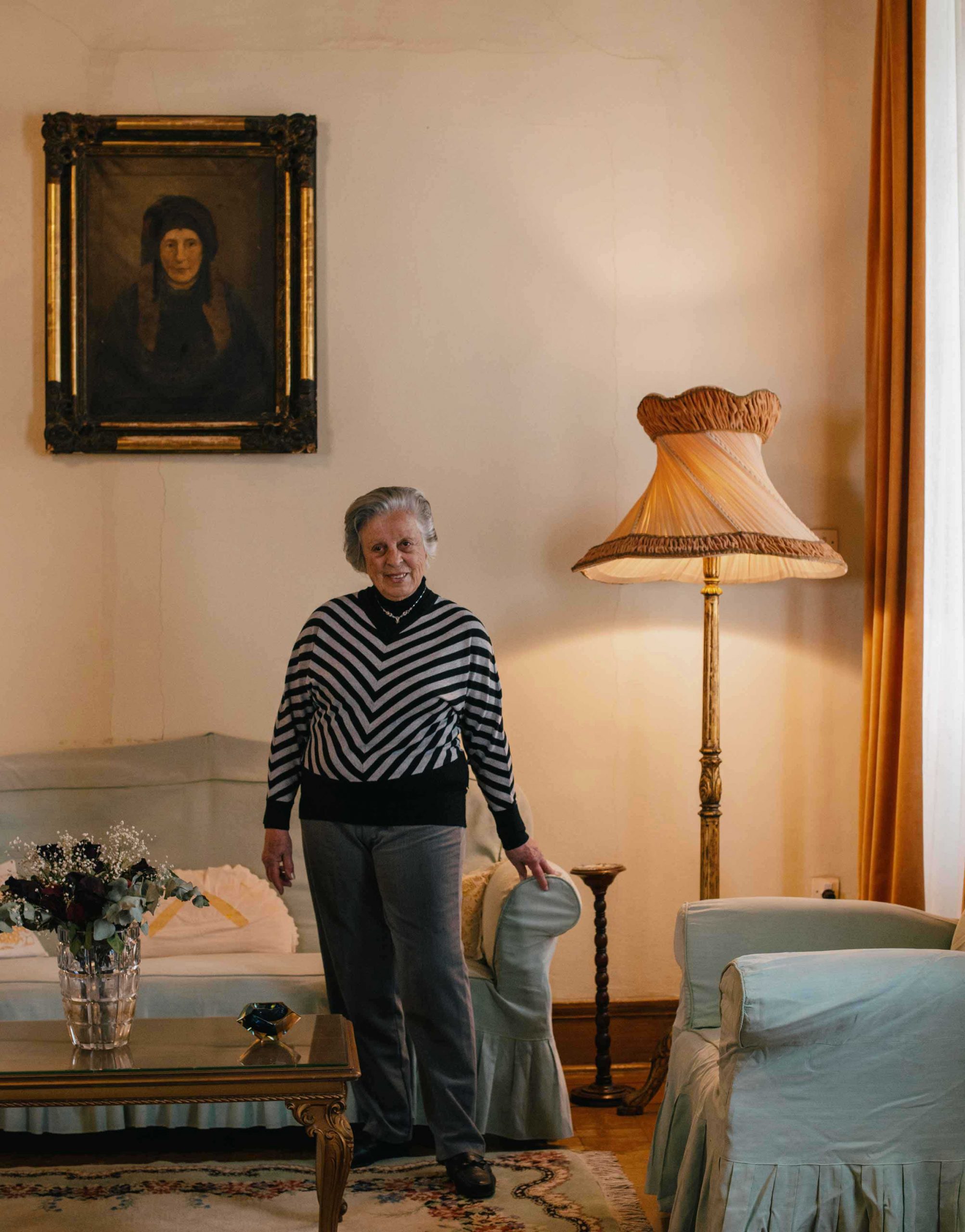
© Angelos Giotopoulos
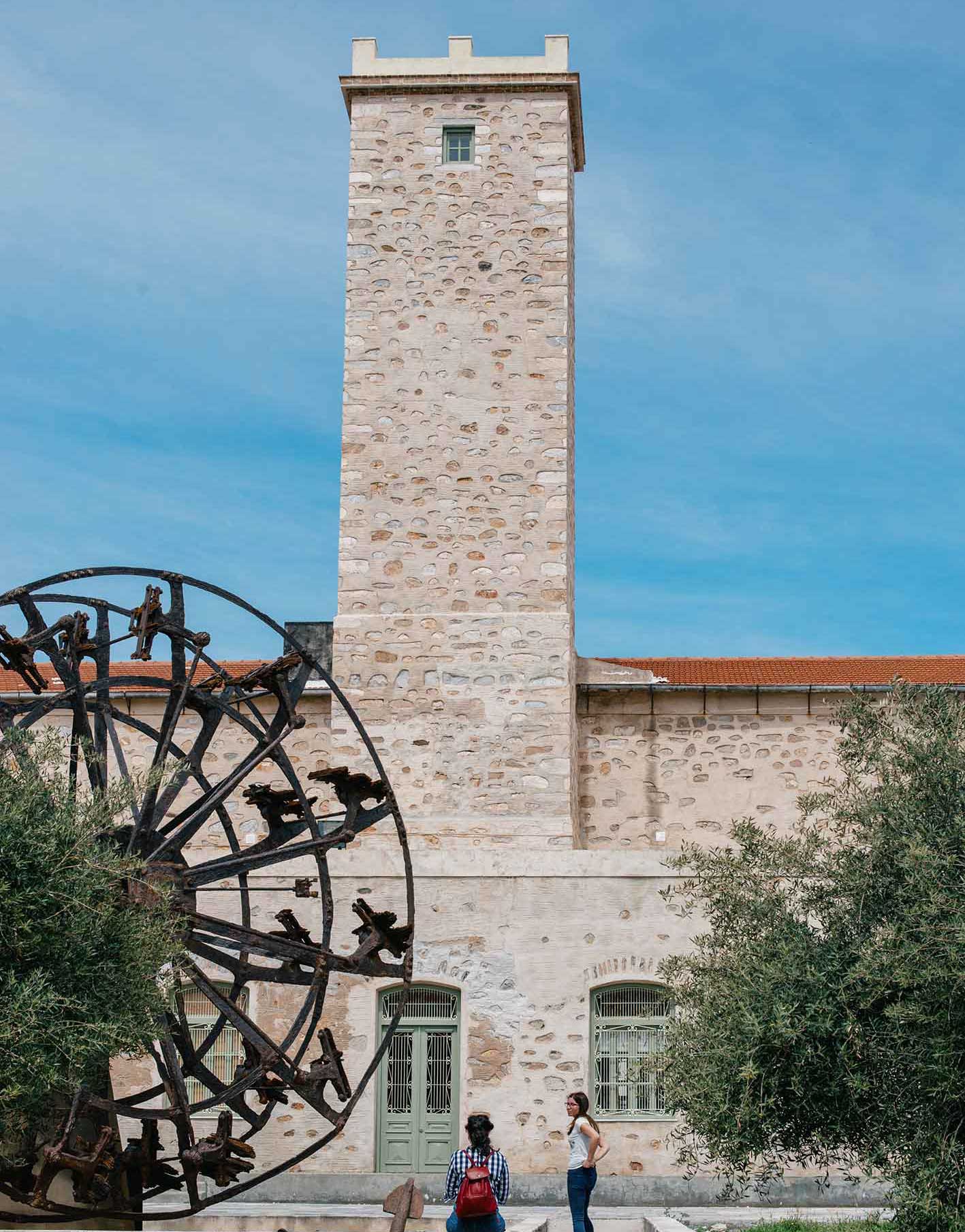
© Angelos Giotopoulos
The Architectural Heritage of the Industrialists
An entirely different aspect of Syros is hidden behind the elaborate wooden doors of the neoclassical dwellings of Ermoupoli. It is the world of industrialists and ship owners of the 19th and 20th century. The impressive economic growth of that period generated Syros’ nickname “little Manchester.” I am following Mrs. Maria Rota, a veteran archaeologist, in a city walk and the emblematic buildings of the city are helping us unravel the thread of its history.
We are meeting outside the majestic City Hall, which is the work of Ernst Ziller. As Mrs. Rota explains to me, the Chians who founded Ermoupoli in 1822 entrusted the design of its infrastructure mainly to Italian and Bavarian architects. The people of Ermoupoli have every right to be proud of a series of firsts, since the first public hospital, the first municipal theatre and the first high school of Greece were founded here, among others. Some of the leather-bound books of the high school can be admired in the wooden bookcases of the atmospheric Historical Archive, which is located next to the City Hall. The archive documents reveal unexpected stories of the island and its inhabitants.
The building of “Hellas Club”, on the other side of the square is reminiscent of the social events it used to host back in 1900, where members of the high society used to be invited and the menus used to be written in French. It is also said that the Greek expression “to look like one just came out of the box” (i.e. dressed to kill) was created to describe the ladies who used to take the expensive clothes they had ordered from France out of their boxes, in order to attend the New Year’s Eve parties.
Opposite the Club is Velissaropoulos Mansion, with an imposing all-marble facade and light rosettes carved on the underside of its balconies. A few meters away, the red velvet seats of the historic Apollo Theater have consistently welcomed their audience since 1864, while on April 29 it will host Grattacielo Theatre from New York.
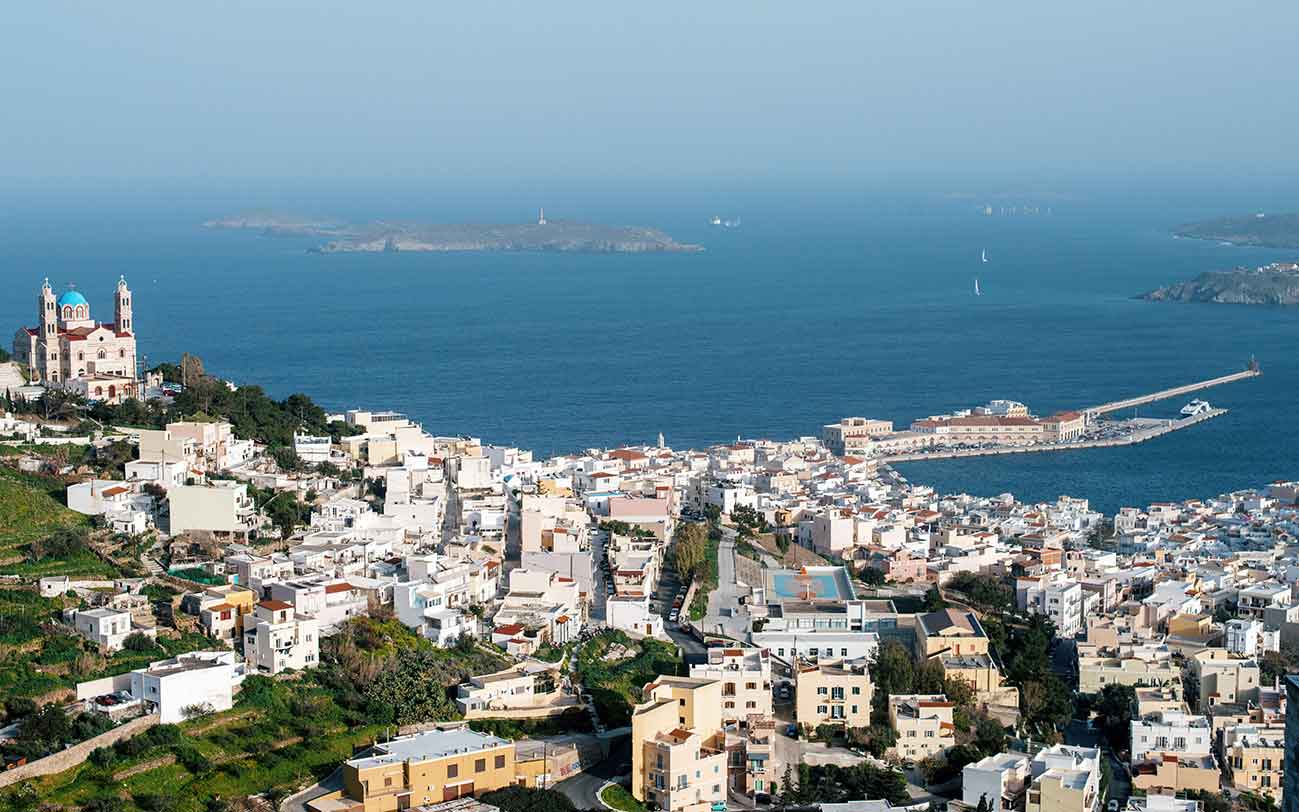
© Angelos Giotopoulos
Passing by the church of Aghios Nikolaos, Mrs. Rota is preparing me for the “small houses”, as she calls them that we are going to see along Babagiotou Street. These are the houses of ship owners, mainly, who chose to live in the quarter of Vaporia, in order to be able to see their ships as they entered the port. We are knocking on the door of one of them, which has been turned into a hotel, to visit its interior. “This used to be the dining room and the bedrooms were upstairs,” whispers Mrs. Rota, and I realise that this house once belonged to her family.
Ornate ceilings, luxurious chandeliers and eminent glass doors with wooden frames and arched lintels create a sense of grandeur. This image brings to mind the sound of a piano. It is said that anyone who took an afternoon walk around the quarter of Vaporia enjoyed an informal concert, listening to the children of affluent families rehearsing to pieces of classical music. Returning back to the city center from Apollonos Street, we are visiting the Prasakakis Mansion, where the Cyclades Chamber is housed, to admire its ceiling paintings.
Urban legend has it that King Othon took a bath in the marble bathtub of this building, while its kitchen houses an exhibition of Cycladic gastronomic products, under the aegis of the Aegean Cuisine initiative. Our walk concludes with a visit to the atmospheric Kois Mansion, famous for the ceiling painting in its living room. This mansion will even open its doors as a place of culture and design this summer, participating, among other things, in the Animasyros Festival.

© Angelos Giotopoulos
An Air of the Belle Époque in the Countryside
Driving up the roads leading to the south of Ermoupoli, the hills are green and the wind is scented with spring flowers. I realise that Ermoupoli has been an urban centre since its foundation and I feel a sense of the countryside as a pleasant change. This desire for fresh air must have been what motivated wealthy Syriots to build holiday homes into pine forests or by the sea, in areas such as Piskopio, Poseidonia and Chrousa.
We make a stop in Parakopi, the holiday settlement of textile workers, and Dimitris Stavrakopoulos explains to me that the club and the church were the central architectural elements and centres of social life of all such settlements, built side by side. The mansions in Chrousa are particularly impressive.
Their large and multi-level gardens, decorated with gazebos, pebbles and pigeon houses, have been designed by Italian and Viennese agriculturalists. In a black and white picture taken back in 1910, I see ladies in period dresses and hats posing with King George on a veranda of a certain mansion.
Τhe architecture of the holiday houses in Poseidonia ̶ also known as Dellagrazia ̶ is even more impressive. Here stand out the towers of the majestic Georgiadis Mansion, but also Petrokokkinos Mansion, with ornate wood-carved elements and a roof that looks like it sprang out of an Oriental tale.
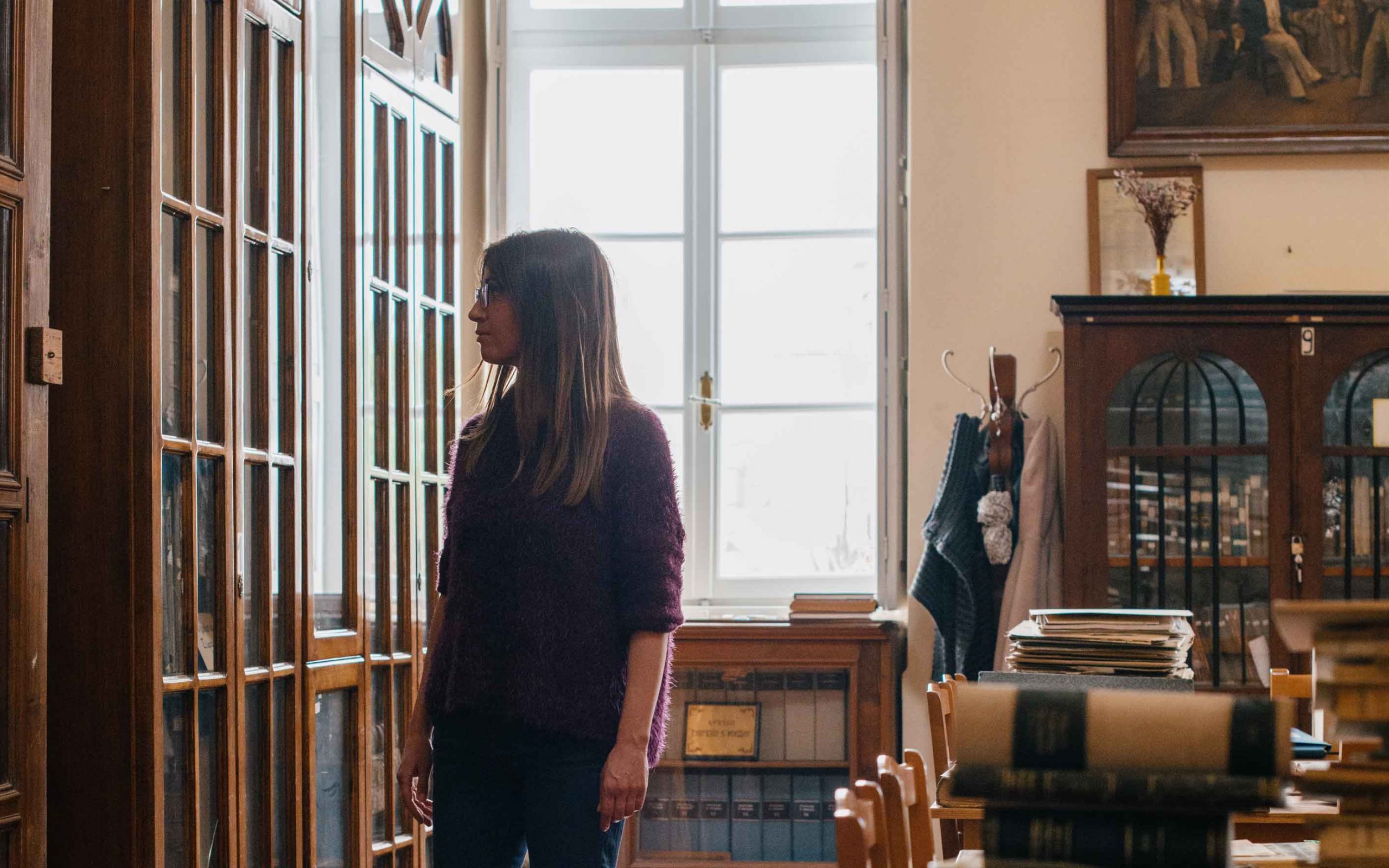
© Angelos Giotopoulos
Industrial History
Gazing at Ermoupoli’s horizon, there are only a few smoke stacks left now out of the over 65 factories that once were working in the area. The Industrial Museum, which is a member of the European Route of Industrial Heritage, is the right place to discover their history. Achilleas Dimitropoulos, the operation manager of the museum, explains that the 25m tower that stands on the museum’s side once belonged to the old lead shot factory that now houses the museum. The molten metal alloy passed through a perforated grid and drops fell from the top of the tower.
The drops were cooled by the air resistance, so that they solidified before landing in a tank of water and turned into hunting shot. The museum’s collections include products and machinery made in Syros as well as imported technology that once was used by the island’s factories. The exhibits come to life through the brilliant descriptions of Achilleas Dimitropoulos; among them, there is a women sock knitting machine dating back in 1920 and the Enfield 8000, the first electric car built in Greece in the 1970s.
A special element of the industrial past of Syros is the nostalgic stone-built lighthouse in Gaidouronisi. It is one of the first ever built in Greece but, above all, it gives you the feeling that it was silently “watching” the whole history of this unexpectedly urban island city.












